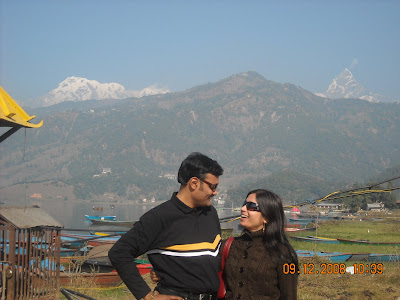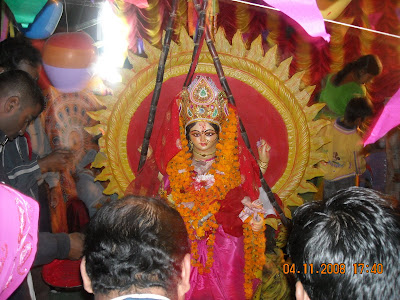The Places and People of Kathmandu
We have been in Kathmandu for the last Seven months

To start with, Kathmandu is situated in the heart of the Himalaya mountains, and has a rich history. Considered by some to be among the most beautiful cities in the world, the earliest known inscription in the Kathmandu Valley is dated 185 AD. The oldest firmly dated building in the earthquake-prone valley is almost 1,992 years old.
Kathmandu is basically a Valley, surrounded by mountains from all the sides and one can see Snow-clad Himalayas in a distance, on a clear day.
(Kathmandu valley,surrounded by Mountains & Snow-clad Himalayas in a distance)

(Kathmandu valley,surrounded by Mountains & Snow-clad Himalayas in a distance)

One of the Iconic structures of Kathmandu is the "Pashupatinath Temple".
It is regarded as the most sacred temple of Shiva (Pashupati) in Nepal. "Shivaratri" or night of lord Shiva is the most important festival celebrated in this temple. Along the shores of the Bagmati river near the temple lies "Arya Ghat", the most widely used place of cremation for the deceased in Nepal, especially in and around the Kathmandu valley. There is also a large market in the streets surrounding the temple. Vendors sell souvenirs to tourists, but also cloth, dyes, and religious supplies. Believers of the faith Hinduism are allowed to enter the temple. Non-Hindu visitors are allowed to have a look at the temple from the other bank of Bagmati river.
I have been to this Temple for the umpteen times, mostly in the evenings, after Office hours.
(View of Pashupatinath Temple, at 17.38 hours)
(View of Pashupatinath Temple, at 17.38 hours)

It is believed that to die and to be cremated here will release one from the cycle of repeated birth and death.
(People performing daily rituals outside the Temple at the evening hours)

Another Iconic structure of Kathmandu, particularly for the Buddhists, is the "Boudhnath Temple". Boudhanath Temple, built in the 5th Century, is the largest Buddhist temple in Nepal.
The temple has a big domed tower (Stupa) in the center, and believers adore the tower.
(The Boudhnath Temple)

(Panoramic view inside the Boudhnath temple Complex)

(One Buddha Idol kept at the entrance of the Complex)

(The foreigners at the Complex)

(The Buddhist monks in the Complex)

(The famous Buddha Idol at the World Heritage site - Boudhnath)

Below is the clear picture of "Lord Boudhnath".

(A beautiful Wall-painting in the Complex)

In Kathmandu, there is one area, named "Patan".Patan is protected by UNISCO world heritage site. It is some time referred to as Lalitpur, which means city of beauty. Patan has long Buddhist history and the four corners of the city are marked by stupas. Patan’s central Durbar square is absolutely packed with temples. It an architectural feast with a far greater concentration of temples per sq meter than in Kathmandu. Numerous other temples widely diverse style as well as many Buddhist monasteries are scattered around this fascinating town. The Patan Durbar square is a concentrated mass of temples, undoubtedly the most visually stunning display of Newari architecture to be seen in Nepal.
(The Patan Durbar Square)

On clear days, Snow-capped mountains can be seen even from my Residence at Kathmandu.

( View from Dhulikhel on a clear day.)

One of the other Tourist attraction at Kathmandu is "Nagarkot".

There is a lookout tower south of the village where you can get a 360º view of the scenery.

In Kathmandu, there is one area, named "Patan".Patan is protected by UNISCO world heritage site. It is some time referred to as Lalitpur, which means city of beauty. Patan has long Buddhist history and the four corners of the city are marked by stupas. Patan’s central Durbar square is absolutely packed with temples. It an architectural feast with a far greater concentration of temples per sq meter than in Kathmandu. Numerous other temples widely diverse style as well as many Buddhist monasteries are scattered around this fascinating town. The Patan Durbar square is a concentrated mass of temples, undoubtedly the most visually stunning display of Newari architecture to be seen in Nepal.
(The Patan Durbar Square)
(The Temples of Patan)

(We at Patan)

(A panoramic view of Patan in the evening)

(Tourists enjoying their time)

(The majestic Temples, looking more majestic at dusk)

Another must-see site in Kathmandu is the "Durbar Square".

(We at Patan)

(A panoramic view of Patan in the evening)

(Tourists enjoying their time)

(The majestic Temples, looking more majestic at dusk)

Another must-see site in Kathmandu is the "Durbar Square".
Kathmandu’s Durbar Square is one of three durbar (royal palace) squares in the Kathmandu Valley. It is the site of the Hanuman Dhoka Palace Complex, which was the royal Nepalese residence until the 19th century and where important ceremonies, such as the coronation of the Nepalese monarch, took place in the past. The palace is decorated with elaborately-carved wooden windows and panels and houses the King Tribhuwan Memorial Museum and the Mahendra Museum. It is also possible to visit the State Rooms inside the palace. At the southern end of Durbar Square is one of the most curious attractions in Nepal, the Kumari Chowk. This gilded cage contains the Raj Kumari, a young girl chosen through an ancient and mystical selection process to become the human incarnation of the Hindu mother goddess, Durba. She is worshipped during religious festivals and makes public appearances at other times for a fee paid to her guards.
(The Durbar Suqare)
(The Durbar Suqare)

(Another view of the Durbar Square)

(Fruits being sold on the streets in the Durbar Square)

(Fruits being sold on the streets in the Durbar Square)
The people of Nepal are a voracious eater of Buffalo, Chicken & Mutton. They also have a liking for green leaves, like, Mustard leaves, Spinach, etc. Their Staple diet consists of Rice, Green leaves, pickles, "Daal" ( lentil Soup), vegetable curry, salad &/or a non-veg item.
(A typical Non-veg Nepali Thali.)
The people of Nepal are mostly Hindus, and are religious to the core. Here, Dussherra and Diwali are celebrated with much fan-fare. Diwali is a festival of lights, but unlike India, here firecrackers are banned.
(Diwali decoration as seen from our Residence)

(A view of the street during Diwali)

(A decoration done on the Road, during Diwali)

Apart from Diwali, People of Nepal also celebrate "Chhat" puja, which is basically a festival of Bihar, India. Lord "Sun" is work shipped during this festival.
( "Chhat" deity work shipped in Kathmandu, on 04.11.2008)

(Diwali decoration as seen from our Residence)

(A view of the street during Diwali)

(A decoration done on the Road, during Diwali)

Apart from Diwali, People of Nepal also celebrate "Chhat" puja, which is basically a festival of Bihar, India. Lord "Sun" is work shipped during this festival.
( "Chhat" deity work shipped in Kathmandu, on 04.11.2008)

Not only during festivals, Nepali people regularly visit Temples and offer prayers to the deities.
( Prayer offerred on a normal day on road-side)
On clear days, Snow-capped mountains can be seen even from my Residence at Kathmandu.
( The view of snow-capped mountains from my residence at dusk)

That was all about Historical & Religious part of Kathmandu.

That was all about Historical & Religious part of Kathmandu.
Now, let me describe the Natural beauty of Kathmandu.
There are two main tourist attraction, namely, "Dhulikhel" & "Nagarkot".
First, Dhulikhel.
Dhulikhel is a typical Newari town with nearby Tamang villages. It is situated 30 km. east of Kathmandu on the side of Arniko Highway on the way towards Tibet/China. Dhulikhel is popular for its natural beauty and ancient traditions. The Himalayan ranges from the twin crest of Mt. Langtang in the west to the Mt. Everest in the east can be clearly viewed in a clear day. Dhulikhel is ideal for snow-capped peaks, sunrise, sunset and it is different from any other place.
(Note : You can point your Mouse on any Photographs shown here and click on it to see the enlarged & clearer view.)
(A panoramic view from Dhulikhel, but on a cloudy day.)
(Note : You can point your Mouse on any Photographs shown here and click on it to see the enlarged & clearer view.)
(A panoramic view from Dhulikhel, but on a cloudy day.)

( View from Dhulikhel on a clear day.)

One of the other Tourist attraction at Kathmandu is "Nagarkot".
Among all the places for mountain viewing in the Kathmandu Valley, Nagarkot is usually considered to be the best. The views go from Dhaulagir in the west to Kanchenjunga in the east. On a clear day you can see Mt. Everest (Sagarmatha). You can also see Manaslu (8,463m), Ganesh Himal (7,111m), and Langtang (7,246m). Many people go up to Nagarkot in the afternoon, stay in a hotel in Nagarkot, and then get up at dawn to see the Himalaya Mountains during the sunrise.
Nagarkot is 32 kilometres east of Kathmandu, on the northeast edge of the Valley at an elevation of 2,175m. It is best to view the mountains in the early morning because it is more likely to be clear.
( View from Nagarkot )
Nagarkot is 32 kilometres east of Kathmandu, on the northeast edge of the Valley at an elevation of 2,175m. It is best to view the mountains in the early morning because it is more likely to be clear.
( View from Nagarkot )

There is a lookout tower south of the village where you can get a 360º view of the scenery.





















No comments:
Post a Comment